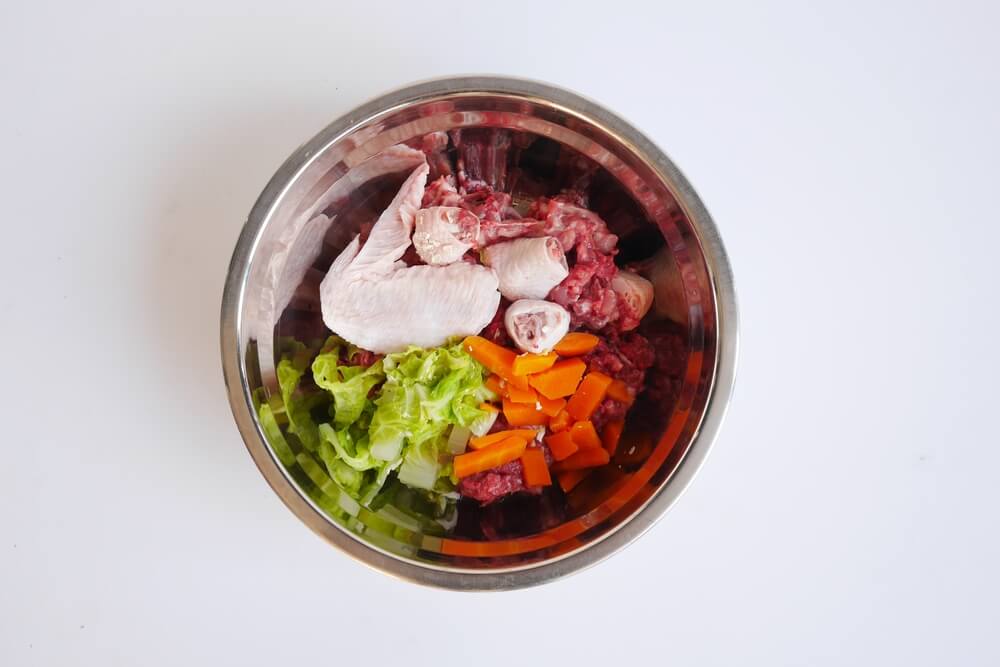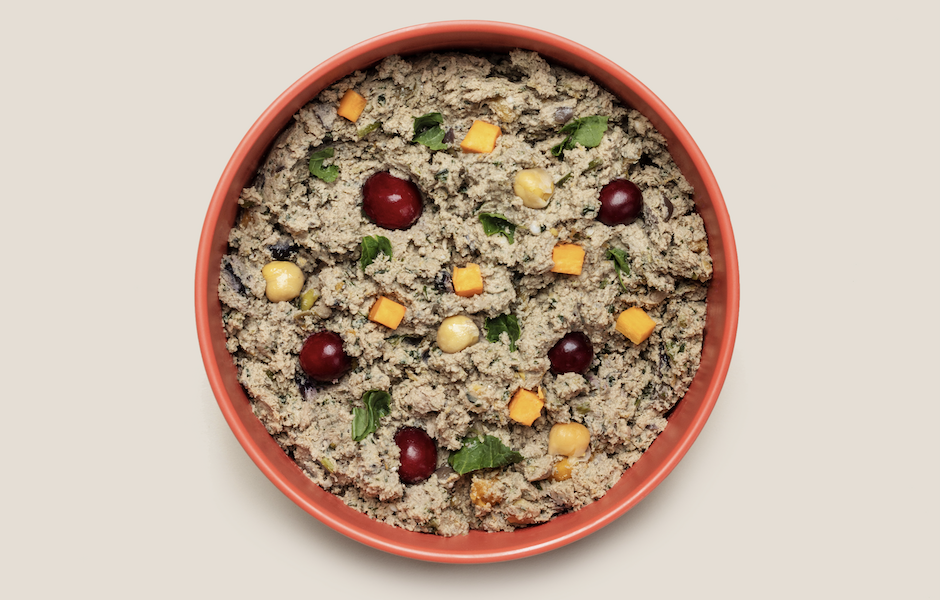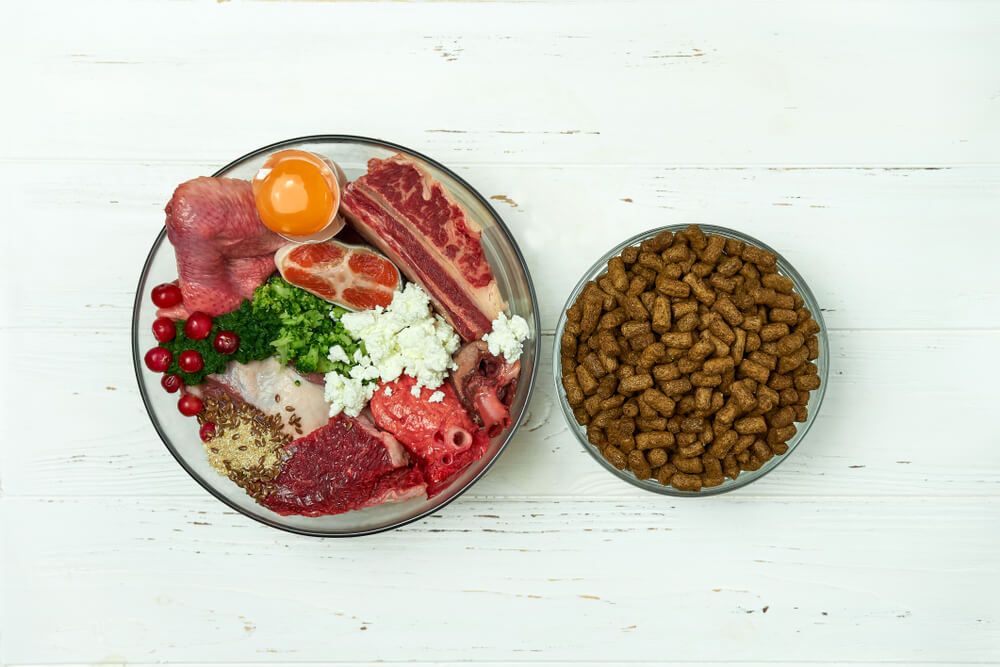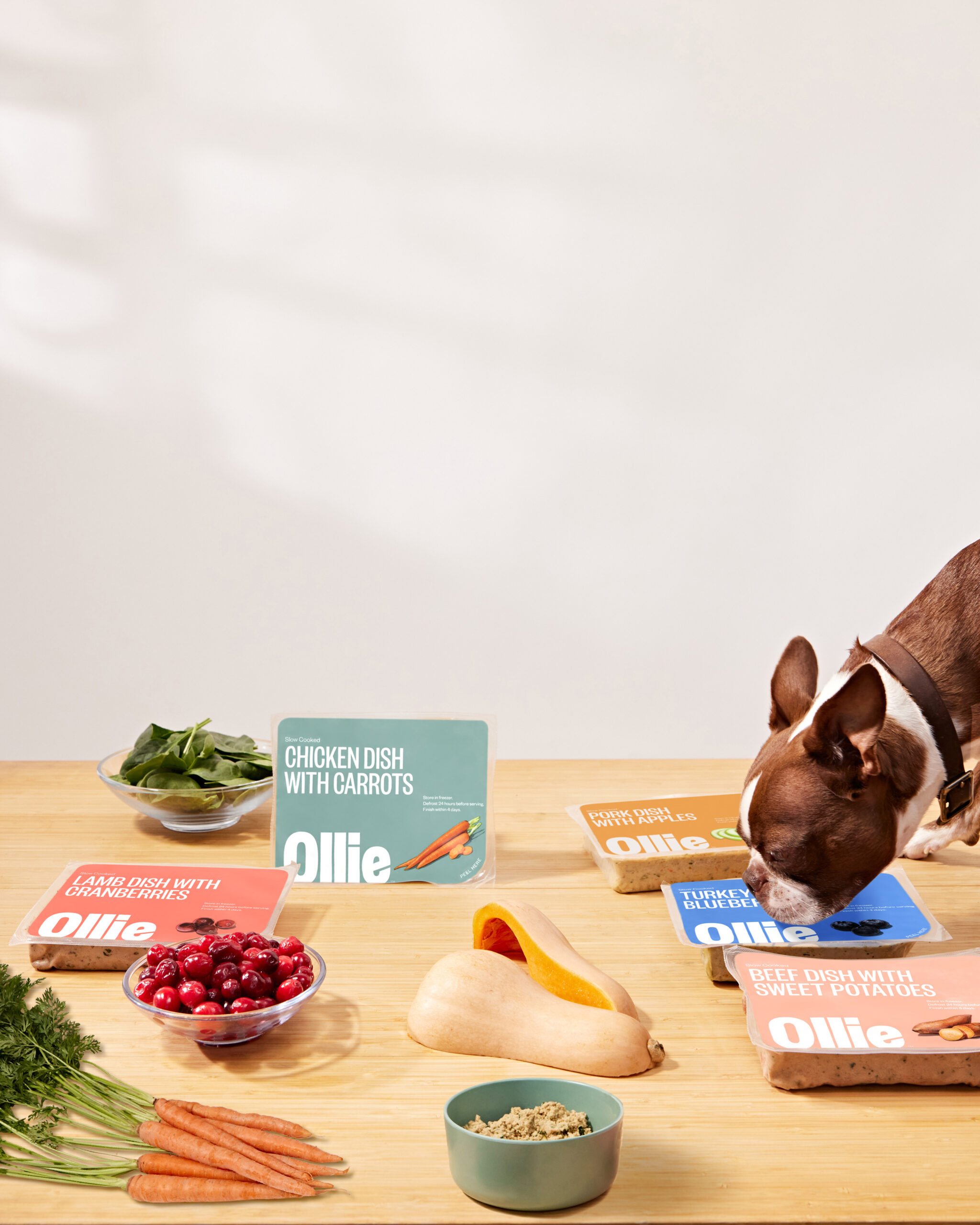Hey Ollie blog readers! We’re offering you an exclusive 60% OFF your starter box! Try now!
Raw Diets for Dogs
 Raw food diets, as implied by their name, involve feeding your dog raw (i.e., uncooked and unprocessed) food. While this most often refers to meat, a raw diet can also include fruits and vegetables, oils, and eggs. Raw food meat sources are often a mix of muscle and organ meats (e.g., kidney, liver and hearts) to create a balance of protein, vitamins, and minerals. Although raw dog food is regarded as having a high nutrient content—thanks to its uncooked state—many raw-feeding dog owners also add nutritional supplements to their dog’s food such as turmeric, coconut oil, or fish oils. Raw diets may also include fermented dairy such as yogurt or kefir. To make raw feeding more convenient, many companies offer prepared raw food recipes in frozen or freeze-dried formulations for easy, hassle-free feeding.
Raw food diets, as implied by their name, involve feeding your dog raw (i.e., uncooked and unprocessed) food. While this most often refers to meat, a raw diet can also include fruits and vegetables, oils, and eggs. Raw food meat sources are often a mix of muscle and organ meats (e.g., kidney, liver and hearts) to create a balance of protein, vitamins, and minerals. Although raw dog food is regarded as having a high nutrient content—thanks to its uncooked state—many raw-feeding dog owners also add nutritional supplements to their dog’s food such as turmeric, coconut oil, or fish oils. Raw diets may also include fermented dairy such as yogurt or kefir. To make raw feeding more convenient, many companies offer prepared raw food recipes in frozen or freeze-dried formulations for easy, hassle-free feeding.
What to Look for in Raw Food Diets
Like other diets, not all raw food diets are equal in quality or nutritional value. If you’re interested in feeding your dog a raw diet, be prepared to research protein types, recipes, ingredient sourcing, manufacturing facilities and processes, and how the food is packaged and transported. Find out if the company has been involved in any recalls for bacterial contamination, which may help you identify concerns with their supply or transportation chain.Raw Food Diet Safety Concerns
Safe food handling is one of the most significant raw feeding concerns among dog owners and veterinarians. Raw meat and other ingredients can harbor dangerous bacteria (e.g., E.coli, Salmonella, Campylobacter, and Clostridia) that may contaminate food surfaces and supplies. Although dogs have a highly acidic stomach and a short digestive tract that protects them from most foodborne bacteria, dog owners can experience serious illness if they do not practice safe food handling strategies. Always maintain good hygiene when preparing, handling, or serving raw food to your pup. This includes washing cutting boards, countertops, knives, dishes, and dog bowls that have come into contact with raw meat or eggs. In addition, clean the floor under your pup’s bowl or place an old towel or sheet under your pup’s bowl to contain the mess. Launder the towel after each meal. If you have young children or anyone in your home who is immunocompromised (i.e., more susceptible to foodborne illness), a raw diet may not be a suitable choice for your household. Before feeding your dog a raw diet, consider the risks to everyone in your home. 10 Benefits of Switching to Fresh Dog FoodCommon Myths About Raw Dog Food
Raw dog food is perhaps the most hotly debated canine nutrition issue on the planet—or at least the internet. Myths and misconceptions abound about this seemingly extreme feeding style, which can quickly lead well-meaning dog owners down a rabbit hole—or a path to the nearest veterinary hospital. Here are a few of the many raw dog food myths and the truths behind them.- Raw food is the optimal diet for every dog — Although raw food is biologically appropriate for canines—meaning that their structure and internal anatomy are evolutionarily designed to handle, process, and digest raw meat-based diets—some dogs cannot tolerate a raw food diet and may experience chronic digestive upset or other complications. As with other food types, it’s important to respect each dog’s individual needs.
- Raw food makes dogs aggressive and blood-thirsty — Raw meat does not change your dog’s behavior or personality.
- Raw diets are just raw meat — While protein is a big component of raw food diets, feeding your dog only meat can lead to dangerous nutritional imbalances. Appropriate raw fed diets must also include bone or bone meal, as well as essential vitamins and minerals (these may come from vegetables and fruits in pre-prepared diets) to ensure appropriate nutrition.
- Veterinarians don’t support raw food diets for dogs — Veterinarians are divided over raw feeding for dogs. Although the American Veterinary Medical Association does not recommend raw food diets, many traditional and holistic veterinarians support raw feeding.
Dry Kibble Diets for Dogs
Kibble is a dry food that is composed of meat, cereal, and plant ingredients that is mixed, cooked at a high temperature, pressed into bite-sized pieces, and baked. Kibble is packaged in shelf-stable bags and can stay fresh for a relatively long time as long as the bag or container has an airtight seal. Always check the expiration date on the package before feeding for safety. Best Food For Dogs With Sensitive Stomachs & Digestive IssuesWhat to Look for in Kibble Diets
Kibble-based diets can be great for pups on the go. If you frequently travel with your dog, a kibble diet is a great choice for convenience alone. But what about nutrition? Kibble can absolutely provide your dog with adequate nutrition. Look for a kibble that meets the AAFCO requirements for a complete and balanced diet to ensure your pup receives adequate nutrition. As with raw food, it is still important to consider the ingredients in kibble. They can vary in quality, and marketing terms can be deceptive. Look for kibble with good sources of protein in the first few ingredients. Avoid kibbles that use corn, wheat, soy, beet pulp, and other cheap fillers. These ingredients may provide adequate energy for your pup, but they lack vital nutrients to keep your dog healthy. As long as your dog isn’t allergic to grains (and most pups aren’t), some grain in their food is actually a good thing.Common Myths About Kibble
Raw diets aren’t the only misunderstood dog food formulation. Here are some common kibble misperceptions and myths, along with the facts behind the fiction- “Meat is the first ingredient” is the mark of high-quality kibble — While it’s important to ensure meat is one of the top ingredients in a kibble diet, a “meat first” food doesn’t necessarily indicate high quality. In fact, because meat contains natural moisture and ingredients are listed by weight, many “meat-first” foods may feature substandard fillers or rely on a deceptive labeling strategy known as ingredient splitting to move meat to the top of the list.
- Kibble is not nutritionally appropriate for dogs — Kibble is a relatively new advancement for dogs, rising to popularity in the 1960’s. And although dry pelleted food may not be what your dog’s ancient ancestors consumed, most kibble recipes are designed to meet AAFCO standards and include essential nutrients for optimal dog health.
- Dogs need dry food to clean their teeth — Regular dry dog food does not help break down plaque and tartar. In the rare instance that dogs actually chew their kibble, saliva-coated food debris that lingers on the teeth and gums can encourage bacterial growth.
- Once you find a kibble that works for your dog you should never change brands or proteins — Rotating dog foods can have numerous health benefits and prevent boredom and finicky behavior. Switching kibble brands and formulas can also minimize your pup’s exposure to harmful chemicals, pesticides, and additives which could cause cumulative damage when fed over a long period of time.
Raw Food Versus Kibble: Which Is Better?
Although this question is a point of contention for many dog owners, according to the American Veterinary Medical Association (AVMA) and the Centers for Disease Control and Prevention (CDC) there is nothing to debate. In fact, the AVMA has issued an official statement against feeding pets a raw diet: “The AVMA discourages the feeding to cats and dogs of any animal-source protein that has not first been subjected to a process to eliminate pathogens because of the risk of illness to cats and dogs as well as humans. Cooking or pasteurization through the application of heat until the protein reaches an internal temperature adequate to destroy pathogenic organisms has been the traditional method used to eliminate pathogens in animal-source protein, although the AVMA recognizes that newer technologies and other methods such as irradiation are constantly being developed and implemented.” But choosing a kibble diet doesn’t mean you have to compromise your pup’s nutrition or forfeit the benefits of feeding fresh foods. Simply use fresh ingredients (e.g., yogurt, fresh fruit or vegetables, sardines, or cooked chicken, beef, or fish) as toppers to maximize the nutrition in your dog’s bowl and keep their diet interesting. But remember, always check with your vet before making any changes to your dog’s diet to ensure you aren’t overfeeding or causing nutritional imbalances. How Do I Tell If My Dog Likes Their Food?Can You Mix Raw Dog Food With Kibble?
Although it isn’t necessarily harmful to combine raw dog food with your pup’s kibble, some dogs may find new pairings difficult to digest and others may eat around one type of food resulting in more waste. Remember, just because something is “natural” doesn’t mean it’s the most appropriate food for your individual dog. In addition, mixing raw meat and kibble can increase your exposure to foodborne pathogens, especially if your dog is a grazer who leaves food in their bowl for prolonged periods of time. For a safer and equally healthy alternative, mix your dog’s kibble with one of Ollie’s fresh food recipes. Every complete and balanced recipe contains “human grade” whole food ingredients and is gently cooked to preserve nutrients, aromas, and flavors while minimizing the risk for food-related illness. In short, your dog gets all the fresh food benefits without any risk—or controversy!

Find Out Which Recipe Plan is Right for Your Dog’s Needs
Get 50% of your first box of Ollie’s fresh delivered meals today!
Take our 5-Minute Quiz!Tagged As:

The nutrition your dog needs,
the food they want.

Enjoying our articles? Subscribe our Newsletters and get new articles directly to your inbox
You might also like
4 June 2025
7 MINS READ
Feed Their Future: Why Human-Grade Food Matters for Puppies
Among the many decisions you’ll make as a new pet parent, choosing the right food for your growing puppy is one of the most important. The quality of your puppy’s diet can impact their developme…
by Ollie Pets
4 June 2025
6 MINS READ
How Does Fresh Dog Food Compare to Homemade?
As pet parents become more conscious about what goes into their dog’s food bowl, many are considering alternatives to traditional kibble. Two increasingly popular options are fresh dog food and ho…
by Ollie Pets
4 June 2025
5 MINS READ
How Can Fresh Dog Food Help with Weight Management?
Maintaining a healthy weight is one of the most important aspects of your dog’s overall health and longevity. Being overweight or underweight can result in health complications and conditions that…







